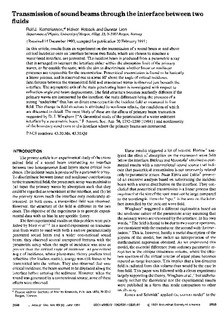Transmission of sound beams through the interface between two fluids
Journal article, Peer reviewed
Permanent lenke
http://hdl.handle.net/11250/108029Utgivelsesdato
1991Metadata
Vis full innførselSamlinger
- Articles [3009]
Sammendrag
In this article, results from an experiment on the transmission of a sound beam at and above critical incidence onto an interface between two fluids, which are chosen to simulate a water/sand interface, are presented. The incident beam is produced from a parametric array that is arranged to intersect the interface either within the absorption limit of the primary waves, or far outside the same, with the aim to discriminate whether linear or nonlinear processes are responsible for the transmission. Postcritical transmission is found to be basically a linear process, and is observed out to about 10° above the angle of critical incidence. Interference between the transmitted field and evanescent waves is observed just beneath the interface. The asymptotic axis of the main penetrating beam is investigated with respect to refraction angle and beam displacement. The field structure becomes markedly different if the primary waves are intersected by the interface, the main difference being the presence of a strong "underlobe" that has no direct counterpart in the incident field as measured in free field. This change in field structure is attributed to nonlinear effects, the candidates of which are discussed in detail. The most likely of these are the effects of primary beam truncation suggested by D. J. Wingham ["A theoretical study of the penetration of a water sediment interface by a parametric beam," J. Acoust. Soc. Am. 76, 1192–1200 (1984)] and nonlinearity of the boundary conditions at the interface where the primary beams are intersected.
Beskrivelse
Journal home page: http://scitation.aip.org/jasa/
